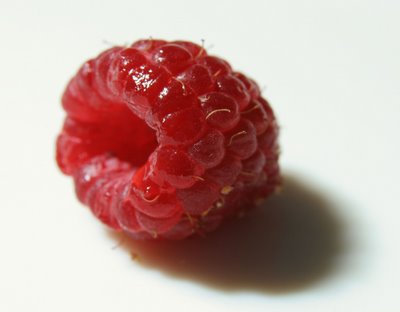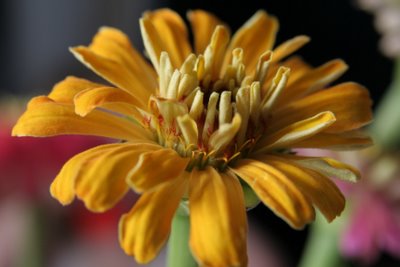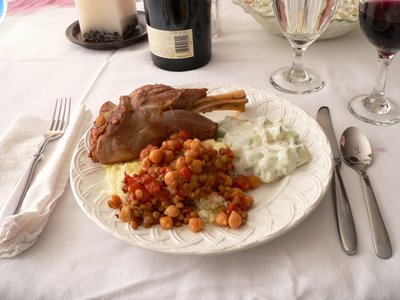Showing posts with label Old Stuff. Show all posts
Showing posts with label Old Stuff. Show all posts
Monday, February 26, 2007
Wedding Pictures
Click here to see the pictures I took this past weekend at my friend's wedding. I was also a groomsman, so the picture collection is necessarily incomplete. I was just one of the extra photographers.
Sunday, January 21, 2007
Negative Selection
Photography like sculpture is in the business of finding meaningful and beautiful materials in the world and then subtracting things until you have a work of art. The most obvious way to subtract things in photography is by excluding them from the frame. However, there are other ways to throw away data. Over exposure and under exposure and the practice of extreme processing remove things from the picture as well. I have thrown much raw material away in the pictures below, and I think they are better for the added simplicity and the increased contrast.






Surreal
Tuesday, January 16, 2007
A Few Shots
This is a flash technique that I may have read about somewhere, or I may just have discovered on my own. Either way, this is how it works: attach your flash with a cord, manually zoom your flash (requires zoom flash), get closer to the subject and use a wide angle with your lens, then point the flash carefully at the subject and take the picture. It creates this kind of spot-light like effect. Good for some situations.
 This is just a good example of good sidelighting. This is a flash photo, which doesn't look too flashy, although the colors are a little less dynamic than in natural lighting.
This is just a good example of good sidelighting. This is a flash photo, which doesn't look too flashy, although the colors are a little less dynamic than in natural lighting.
 I was able to get this glassy smooth look by leaning against a tree and slowing down my shutter speed. The fact that the camera is digital allowed me to experiment and try many times until I was getting a picture that I was satisfied with.
I was able to get this glassy smooth look by leaning against a tree and slowing down my shutter speed. The fact that the camera is digital allowed me to experiment and try many times until I was getting a picture that I was satisfied with.

 This is just a good example of good sidelighting. This is a flash photo, which doesn't look too flashy, although the colors are a little less dynamic than in natural lighting.
This is just a good example of good sidelighting. This is a flash photo, which doesn't look too flashy, although the colors are a little less dynamic than in natural lighting. I was able to get this glassy smooth look by leaning against a tree and slowing down my shutter speed. The fact that the camera is digital allowed me to experiment and try many times until I was getting a picture that I was satisfied with.
I was able to get this glassy smooth look by leaning against a tree and slowing down my shutter speed. The fact that the camera is digital allowed me to experiment and try many times until I was getting a picture that I was satisfied with.
Sunday, October 15, 2006
More Macro Shots
Monsieur Twig was a fun macro study. You can see a video of him here.
 I didn't use a flash for this shot below, since it was outside and there was enough light.
I didn't use a flash for this shot below, since it was outside and there was enough light.
 He does a pretty good job acting, doesn't he?
He does a pretty good job acting, doesn't he?
 Although sometimes he gets confused and does an impression of a twig growing off the handle of my camera bag.
Although sometimes he gets confused and does an impression of a twig growing off the handle of my camera bag.
 Here's another picture of a zinnia. I liked the different perspective on this one.
Here's another picture of a zinnia. I liked the different perspective on this one.

 I didn't use a flash for this shot below, since it was outside and there was enough light.
I didn't use a flash for this shot below, since it was outside and there was enough light. He does a pretty good job acting, doesn't he?
He does a pretty good job acting, doesn't he? Although sometimes he gets confused and does an impression of a twig growing off the handle of my camera bag.
Although sometimes he gets confused and does an impression of a twig growing off the handle of my camera bag. Here's another picture of a zinnia. I liked the different perspective on this one.
Here's another picture of a zinnia. I liked the different perspective on this one.
Friday, October 06, 2006
Macro with a Flash
Getting nice sharp macro shots with an SLR camera can be very difficult due to the extremely narrow area of focus when you move your camera so close to the usually very small object. This problem is, of course, compounded when there isn't enough light and you want to keep the aperture wider. So it would be very nice to use a flash in macro photography to allow you to get greater depth of field with a smaller aperture. "So what?" you say, "just turn on the flash." Ah, but the next problem presents itself. When your camera is a few inches away from a flower the flash does not point at or hit the flower. It isn't designed to light objects that are right in front of the lens. Hence an off the camera flash or some way of bouncing or directing the flash is necessary. For the following shots I've used a Quantaray 6500 flash and a 9500 flash with a variety of different modules (one that I got to use with my old Pentax Spotmatic, one for a Nikon Manual Focus, and One for Canon Auto Focus that will only work if you cover one of the contacts with electrical tape, more on that later). In order to get the flash off the camera you either need a dedicated sync cord (usually about $50) or with this Quantaray system you can buy the QPH 5000 flash handle (holds batteries and integrates with module and flash) from your local Ritz, Kitz, or Wolf Camera store for about $25, or you can find a dozen flash and handle combinations on ebay for between $10 and $40. That is for the flashes that do not integrate with your Canon (and I assume Nikon would be similar) integrated TTL (Through The Lense) or ETTL or iTTL or whatever they call the auto flash exposure system. If you are on a budget and you want to play around with flashes these quantaray flashes are really quite a deal--especially on Ebay. Most of the modules will allow you to use the flash with at least two different power output settings-- full and 1/16th. I regulate the brightness of the flash by setting the camera to full manual mode, set the ISO to 200, set the shutter speed to 60, and then change the F-stop and the distance/ bounce of the flash to adjust the brightness for each situation. Of course, digital makes this process to much easier, since you can take one frame and then look at it to evaluate the exposure.
Now for the specifics of these pictures.
This is a rasberry on a plate. The white plate provides a nice background and the off the camera flash allows me to creat a nice sidelit macro with a very distinct shadow. I would not have anything worth looking at if I had taken this picture without a flash. Of course, you could accomplish the same thing with a plate in bright sunlight.
 This flower, a zinnia, is also lit from the side and above--a generally nice lighting angle. Being able to control the lighting allows you to experiment and play around to see what looks good.
This flower, a zinnia, is also lit from the side and above--a generally nice lighting angle. Being able to control the lighting allows you to experiment and play around to see what looks good.
 I am not a big fan of macro photography, but this photo (below) kindled a new interest in the small world for me. The little flames that show up at the center of the flower are stunning and beautiful. You have to look very closely in real life to see them.
I am not a big fan of macro photography, but this photo (below) kindled a new interest in the small world for me. The little flames that show up at the center of the flower are stunning and beautiful. You have to look very closely in real life to see them.

Now for the specifics of these pictures.
This is a rasberry on a plate. The white plate provides a nice background and the off the camera flash allows me to creat a nice sidelit macro with a very distinct shadow. I would not have anything worth looking at if I had taken this picture without a flash. Of course, you could accomplish the same thing with a plate in bright sunlight.
 This flower, a zinnia, is also lit from the side and above--a generally nice lighting angle. Being able to control the lighting allows you to experiment and play around to see what looks good.
This flower, a zinnia, is also lit from the side and above--a generally nice lighting angle. Being able to control the lighting allows you to experiment and play around to see what looks good. I am not a big fan of macro photography, but this photo (below) kindled a new interest in the small world for me. The little flames that show up at the center of the flower are stunning and beautiful. You have to look very closely in real life to see them.
I am not a big fan of macro photography, but this photo (below) kindled a new interest in the small world for me. The little flames that show up at the center of the flower are stunning and beautiful. You have to look very closely in real life to see them.
Saturday, September 16, 2006
Digital Photography Online Class #1
| This is the first in an eight class series of screen videos I recorded of an online class I was teaching about digital photography. | |
Tuesday, September 12, 2006
A Baseline
By way of an introduction to this PhotoBlog I wanted to give you all and idea what tools I use and what kind of priorities I have in photography.
First, let me list the main cameras I have experience with and what each has contributed to my knowledge of photography.
1. An old Pentax Spotmatic was my first camera, manual focus, manual exposure... with, however, a handy exposure meter. This camera provided me with an understanding of exposure (shutter, aperture, and Film) and some basic exposure to what was possible with a decent camera and lens.
2. A Panasonic Lumix LC33 was my first digital camera with pictures that exceeded the resolution of my computer monitor. This camera opened the world of digital photography to me. I could experiment with this camera due to the fact that it was digital, and it included a spotmeter that allowed me to be somewhat selective about exposure, although it didn't have any manual controls beyond the standard whitebalance, ISO, and other digital camera settings.
3. A Panasonic Lumix FZ20 was second digital camera and was an amazing tool. And although I have moved on to a DLSR I am still quite sure that the days of the dominance of the DLSR are numbered, partially due to my experience with this camera. The FZ20 was a great camera and inspired me to learn a lot about photography in general and allowed me to experiment with different exposures, external flash (luckily the Quantaray flash for my old Pentax worked on my FZ20**more on this later**). The FZ20 is a serious tool, not a toy, and I wholeheartedly recommend it for anyone interested in photography.
4. My current camera is a Digital Rebel XT and I'm not exactly sure what I'm learning with it yet, except that I enjoy the ability to use wider angle lenses and the more complete integration with other equipment. Oh, the battery life on the XT is phenomenal. The DSLR has introduce the new world of focus errors and the shallow depth of field even at wide angle focal length. The incredible difference between the DSLR and the Digicam in my experience is the quality of the data gathered by the DSLR. The files just feel fuller and more flexible in post processing. The lenses I have are:
First, let me list the main cameras I have experience with and what each has contributed to my knowledge of photography.
1. An old Pentax Spotmatic was my first camera, manual focus, manual exposure... with, however, a handy exposure meter. This camera provided me with an understanding of exposure (shutter, aperture, and Film) and some basic exposure to what was possible with a decent camera and lens.
2. A Panasonic Lumix LC33 was my first digital camera with pictures that exceeded the resolution of my computer monitor. This camera opened the world of digital photography to me. I could experiment with this camera due to the fact that it was digital, and it included a spotmeter that allowed me to be somewhat selective about exposure, although it didn't have any manual controls beyond the standard whitebalance, ISO, and other digital camera settings.
3. A Panasonic Lumix FZ20 was second digital camera and was an amazing tool. And although I have moved on to a DLSR I am still quite sure that the days of the dominance of the DLSR are numbered, partially due to my experience with this camera. The FZ20 was a great camera and inspired me to learn a lot about photography in general and allowed me to experiment with different exposures, external flash (luckily the Quantaray flash for my old Pentax worked on my FZ20**more on this later**). The FZ20 is a serious tool, not a toy, and I wholeheartedly recommend it for anyone interested in photography.
4. My current camera is a Digital Rebel XT and I'm not exactly sure what I'm learning with it yet, except that I enjoy the ability to use wider angle lenses and the more complete integration with other equipment. Oh, the battery life on the XT is phenomenal. The DSLR has introduce the new world of focus errors and the shallow depth of field even at wide angle focal length. The incredible difference between the DSLR and the Digicam in my experience is the quality of the data gathered by the DSLR. The files just feel fuller and more flexible in post processing. The lenses I have are:
- Kit lens--Canon 18-55 (for sale if anyone wants it)
- Sigma 55-200 (also for sale)
- Tamron SP 28-75 F2.8 (this is a great lens)
- Sigma 17-70 F2.8-4.5
- Canon 50 F1.8
- Canon 70-300 F4-5.6 IS
- GIMP for Windows
- XnView
- The National Geographic Field Guides
- The Best of Portrait Photography
- The Best of Wedding Photography
- **more to come**
Saturday, April 01, 2006
Sunday, February 19, 2006
Subscribe to:
Posts (Atom)


